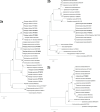Digenean trematodes (Trematoda: Digenea) parasitizing the digestive system of the great cormorant (Phalacrocorax carbo) in Hungary
- PMID: 39989498
- PMCID: PMC11846146
- DOI: 10.2478/helm-2024-0033
Digenean trematodes (Trematoda: Digenea) parasitizing the digestive system of the great cormorant (Phalacrocorax carbo) in Hungary
Abstract
Great cormorants (Phalacrocorax carbo) are widespread piscivorous birds, which cause huge economic losses in the fish fauna worldwide. As a consequence of their predatory behaviour, they serve as definitive hosts for many digenean trematodes, and their digestive systems usually contain several parasite species. Between 2019 and 2022, 131 bird carcasses were collected from Biharugra (Hungary) as culling on the cormorant population. Their digestive systems were subjected to parasitological examination. The studied organs (131 intestines, 44 stomachs and 21 pharynxes) were opened, and their contents were settled in water, filtered, and sorted under microscope. For species identification, sequence analysis of the ITS region was performed. Of the 131 birds, 118 were infected by tapeworms or nematodes, 105 with trematodes, and 10 were parasite-free. The vast majority of obtained sequences (57 of the 105 trematodes) belonged to the genus Petasiger (43/57) and Hysteromorpha triloba (13/57). A single specimen of Metorchis sp. (1/57) as a zoonotic trematode was recorded during our survey. The results confirmed the high trematodes prevalence of the examined cormorants. However, most of them are not considered as human pathogens.
Keywords: Digenea; Hungary; ITS region; Phalacrocorax carbo; great cormorant; trematodes.
© 2024 M. Gyöngy et al., published by Sciendo.
Conflict of interest statement
Conflict of Interest The authors declare that they have no conflicts of interest.
Figures


Similar articles
-
Digenean fauna of the great cormorant Phalacrocorax carbo sinensis (Blumenbach, 1798) in the brackish waters of the Vistula Lagoon and the Gulf of Gdańsk (Poland).Wiad Parazytol. 2003;49(3):293-9. Wiad Parazytol. 2003. PMID: 16889033
-
Morphologic and molecular identifications of digenetic trematodes in double-crested cormorants (Phalacrocorax auritus) from the Mississippi Delta, USA.J Wildl Dis. 2014 Jan;50(1):42-9. doi: 10.7589/2012-10-249. Epub 2013 Oct 25. J Wildl Dis. 2014. PMID: 24171572
-
Clinostomum poteae n. sp. (Digenea: Clinostomidae), in the trachea of a double-crested cormorant Phalacrocorax auritus Lesson, 1831 and molecular data linking the life-cycle stages of Clinostomum album Rosser, Alberson, Woodyard, Cunningham, Pote & Griffin, 2017 in Mississippi, USA.Syst Parasitol. 2018 Jul;95(6):543-566. doi: 10.1007/s11230-018-9801-5. Epub 2018 May 31. Syst Parasitol. 2018. PMID: 29855982
-
Ecology and diversity of digenean trematodes of reef and inshore fishes of Queensland.Int J Parasitol. 1994 Sep;24(6):851-60. doi: 10.1016/0020-7519(94)90011-6. Int J Parasitol. 1994. PMID: 7982747 Review.
-
Checklist of digenean trematodes of Iran.Vet Parasitol Reg Stud Reports. 2021 Apr;24:100571. doi: 10.1016/j.vprsr.2021.100571. Epub 2021 Apr 17. Vet Parasitol Reg Stud Reports. 2021. PMID: 34024387 Review.
References
-
- Ai L., Chen H., Zhang Y.N., Zhou X. N., Li H., Chen M.X., Guo J., Cai C., Zhu X.Q., Chen J.X.. Sequences of internal transcribed spacers and two mitochondrial genes: effective genetic markers for Metorchis orientalis. J Anim Vet Ad. 2010;9:2371–2376. doi: 10.3923/javaa.2010.2371.2376. - DOI
-
- Biedunkiewicz A., Dziekońska-Rynko1 J., Rokicki J.. Black cormorant Phalacrocorax carbo (L., 1758) as a vector of fungi and parasites occurring in the gastrointestinal tract. Biologia. 2012;67(2):417–424. doi: 10.2478/s11756-012-0012-2. - DOI
-
- Edelényi B.. Mételyélősködők a Hortobágy vadonélő gerinceseiből [Reptiles from the wild ridges of the Hortobágy]. Debreceni Déri Múzeum Évkönyve. Debrecen, Hungary. 1972:5–34. (In Hungarian)
LinkOut - more resources
Full Text Sources
Research Materials
